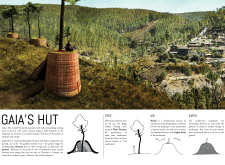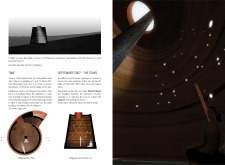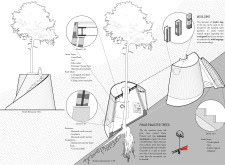5 key facts about this project
The core concept of Gaia's Hut is inspired by elements from the natural world—earth, air, and trees. Each of these components plays a vital role in both the architectural design and the experience it provides to users. The structure acknowledges the earth by utilizing rammed earth techniques that not only create walls but also ground the building into the site. These walls reflect the colors and textures of the landscape, promoting a sense of belonging and permanence.
Functionally, Gaia's Hut is designed as a multi-purpose space centered around meditation and introspection. The circular layout encourages visitors to engage with their environment actively, as it allows for free movement and interaction. Each area within the hut is purposefully created to accommodate various forms of meditation and mindfulness practices, fostering individual exploration and personal connection to the surroundings.
An essential aspect of the design is its unique treatment of light and air. Strategically placed openings in the hut allow natural light to filter through, creating a dynamic interplay of shadows and illumination throughout the day. This thoughtful design not only enhances the atmosphere but also connects users to the changing environment outside. The careful consideration of airflow encourages visitors to experience the gentle breezes and the subtle sounds of nature, further deepening the immersive experience.
Materiality plays a significant role in the overall aesthetic and environmental performance of the project. The integration of rammed earth provides excellent thermal mass and natural insulation, promoting energy efficiency and sustainability. The use of locally sourced timber logs aligns the structure with its geographic location and supports a sustainable harvesting philosophy. Corrugated steel roofing offers durability while allowing for green planting that promotes biodiversity and adds an additional layer of natural insulation.
Gaia's Hut features several unique design approaches that distinguish it within architectural discourse. For instance, the integration of existing pine trees into the layout not only preserves the site’s natural character but also imbues the project with a sense of continuity and respect for the local ecosystem. Various meditation spaces are positioned in relation to these trees, providing focal points for contemplation while allowing users to engage with the tree’s significance during their practice.
The project also embraces flexibility in its use of space. Modular furniture accommodates varying meditation styles and personal preferences, enabling visitors to mold their environments according to their needs. This adaptability enhances the overall functionality of the design, allowing for a more personalized experience.
The architectural plans, sections, and elevations reveal an intricate relationship between the structure and the landscape. The plans illustrate how each element has been thoughtfully arranged to maintain a balance between form and function. Architectural sections provide insight into the building's interplay with light and air while also emphasizing its sustainable features.
In summary, Gaia's Hut is a meaningful architectural project that exemplifies thoughtful design while promoting mindfulness and a deep connection to nature. The integration of sustainable materials, innovative spatial configurations, and respectful interaction with the surrounding landscape illustrates a contemporary architectural approach that values both the environment and human experience. For a more comprehensive understanding of the project, including architectural plans and designs, interested readers are encouraged to explore the full presentation of Gaia’s Hut.


























